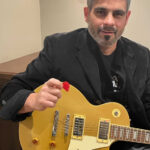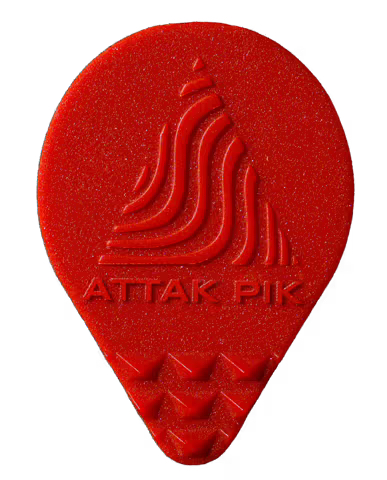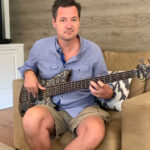Every professional guitarist I know is on a never-ending quest to perfect their tone. My favorite example is famed shredder Eric Johnson (who I don’t know). According to legend, Johnson has an effects pedal he won’t use when a “fully-charged battery is installed because it sounds way better with a run-down battery.” Wow.
Since no guitarist ever said, “I’m content with my sound”, over $10 billion is spent each year on the three big links in the sonic chain: guitars, effects pedals and amplifiers. But musicians Mark Labbe and Michael DePietro, co-founders of Acoustik Attak, are focusing on a link that guitarists/bassists often overlook: the pick.

Acoustik Attak Co-Founder Michael DePietro
Their flagship product – the Attak Pik – is the world’s first 3D guitar pick. It features a patented series of ridges, bumps and diamonds that create multiple strikes on strings, enhanced harmonics, and new frequencies.

ATTAK 1 by Acoustik Attak
How does it work? Typically, a guitar string is plucked either with bare fingers or a plastic pick. The sound of a picked string tends to be more brilliant (i.e. more amplitude in the higher frequencies) whereas a string plucked by a finger tends to sound more dull.*
Until recently, guitarists cared only about a pick’s ease-of-use: thickness, core material, texturing that makes it easier to hold (and impress fans). Labbe and DePietro saw unrealized potential on the business end of the pick: the part that actually strikes the string. So they generated prototype picks with a 3D printer that were textured with a series of raised bumps, ridges, diamonds.
The result was instantly audible. Playing a guitar with their early prototype produced harmonics, brighter tones, percussive effects, and frequencies they couldn’t get with flat picks. In the worlds of guitarist Jacob Rozmajzl:
“I am able to cut through my mixes while still retaining the full-bodied sound I love. The ridges give the illusion of plucking the string without removing the fluidity and versatility needed when using a pick.”
Check out this video in which Finnish virtuoso Mika Tyyskä demonstrates the difference between a traditional flat pick and the latest picks offered by Attack Pik:
To my ears, the difference is palpable. The producer in me can’t wait to mix a song where the guitarist used a pick by Attack Pik. The resulting guitar track will require less compression and less EQ. The resulting guitar track will sit better in the mix.

Acoustik Attak Co-Founder Mark Labbe
Labbe and DePietro have built a thriving business around this principle. Today Attak Pik’s product line features a variety of specialized picks: Stealth, Stealth II, Steal XL, Ambush and Mekanik Glo. And their website features of 3,000 positive reviews. Prices range from $9.99 for a pack of five to $14.99 for a pack of ten.
If you’re a guitarist/bassist seeking the perfect tone, shop today for Acoustik Attak products at https://attakpik.com/collections/attakpiks.
And if someone could let Eric Johnson know that’d be great.
*The “dullness” that comes from finger-picking didn’t deter guitarist Mark Knopfler of the Dire Straits from recording classic guitar riffs we hear on the radio every single day. Shame on us for not using a friendlier descriptor.
Sources:
________________________________________________________________________
Mike Bielenberg is a professional musician and co-founder of http://www.musicrevolution.com, a production music marketplace with over 80,000 tracks online where media producers, video producers, filmmakers, game developers, businesses and other music buyers can license high-quality, affordable royalty-free music from an online community of musicians.